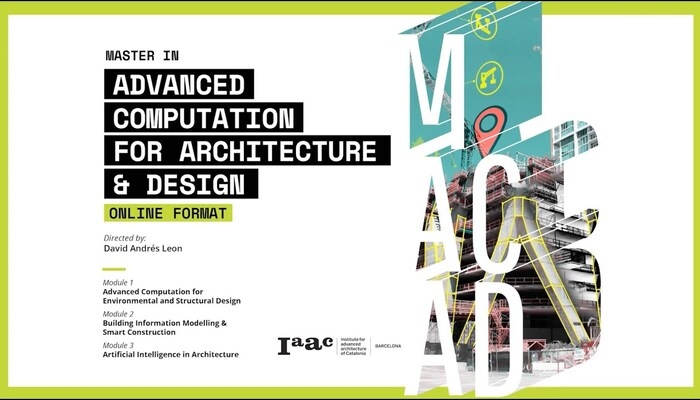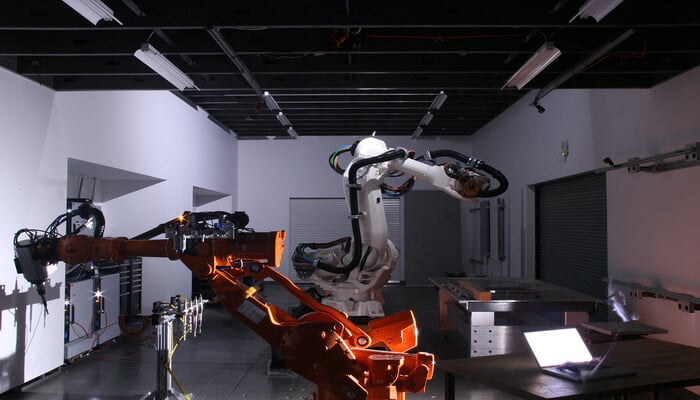Top 7 Computational Design Courses for Architects to Elevate Their Career in 2026

Table of Contents
In today’s time and age, being an architect requires you to be more than just a design thinker.
The global Architecture, Engineering, and Construction industry (AEC) is growing at a CAGR of 10.2%, so your role as an architect is shaping up to become more well-rounded. As a new-age professional, you are expected to be more mindful, calculative, and realistic about your designs- all while not compromising your creative streak. Being a master in Computational Design is proving to be extremely helpful.
What Is Computational Design?

Computational Design is a transformative approach that harnesses the power of algorithms and computer-generated processes to inform and enhance architectural designs. Being a master in Computational Design you can reinterpret the traditional realms of design by integrating advanced visualisation tools, parametric modelling, and simulation techniques to explore design solutions iteratively. The ideas so generated align with the architect's specific goals and constraints. Rhino, Grasshopper, Dynamo, Revit, and Tekla Structures are the most popular and widely used software for Computational Design.
Read: Understanding Computational Design (The Ultimate Guide)
Top 7 Computational Design Courses For Architects
As technology progresses, learning Computational Design will become a mandate for architects. Top architecture firms such as Zaha Hadid Architects, Bjarke Ingels Group, and Foster + Partners are now hiring architects who are well-versed in Computational Design tools.
So, if you are looking for Computational Design architecture jobs at such firms, here is a list of Computational Design courses that can propel your career to the next level.
|
Program |
Duration |
Focus Area |
|
Master Computational Design – Novatr |
6 months |
Parametric Design, BIM |
|
M.S. Computational Design Practices – Columbia University |
3 semesters |
Data Visualization, Urban Systems |
|
Advanced Computation for Architecture & Design – IAAC |
10 months |
Generative Design, AI |
|
Advanced Architectural Design – CMU |
2 years |
Digital Fabrication |
|
Emerging Technologies & Design – AA School |
1 year |
AI, Robotics |
|
Intro to Computational Design – Harvard |
8 weeks |
Algorithms, Iterative Design |
|
M.S. Computational & Advanced Design – DesignMorphine |
9 months |
Parametric Tools |
1. Master Computational Design by Novatr
Mode: Online
Duration: Six months
A six-month online course covering Parametric Design, Generative Design, and BIM through 12+ software and plugins
This course is offered by Novatr, an ed-tech platform for AEC professionals. Out of the Computational design courses available online, this course stands out.
This Computational design course provides architects with an immersive journey into the world of Computational Design. The course covers in detail about Parametric Design, Generative Design, BIM, and sustainability.
Here’s what you’ll learn in detail:
- Learn 5 powerful industry tools — Grasshopper, Rhino 3D, Flux.ai, ComfyUI, and D5 Render.
- Master popular plugins like Paneling Tools, DeCoding Spaces, Anemone, Galapagos, Wallacei, LunchBox, Open nest and Horster Animation to create smarter, faster design workflows.
- Understand how to build parametric and generative design workflows used by top global firms.
- Learn how to automate repetitive design tasks, explore AI-driven creativity, and produce high-quality renders for presentations.
- Develop a professional computational design portfolio showcasing your project-based learning.
Earn dual certification from Novatr and NSDC (National Skill Development Corporation) upon completion, and step confidently into the world of future-ready architecture and design.
2. Master Of Science In Computational Design Practices by Columbia University

Mode: On-Campus
Duration: Three Semesters
Offered by Columbia University, this Computational Design architecture course is curated with the intent of sharing practical knowledge with the learners. The course curriculum encompasses architecture, data visualisation, and urban planning, focusing on built environments of various scales. It encourages critical thinking and engagement among learners, establishing the principles of Computational Design in theory and practice.
The course faculty provides insight into data analysis, Geographic Information Systems (GIS), Building Information Modelling (BIM), and renders interface design to give the participants exposure to technical skills.
3. Master In Advanced Computation for Architecture & Design by IAAC

Mode: Online
Duration: Ten months
The Institute for Advanced Architecture of Catalonia (IAAC) offers a one-of-its-kind Computational Design online course enabling architects to master technical and theory knowledge in the field. This course explores Generative Design, AI-driven workflows, and simulations for sustainable, performance-driven projects.
Participants get the opportunity to explore environmental and structural design, application of BIM in smart construction, and Artificial Intelligence (AI)- all in context to Computational Design. Each course module is tailored to provide the participant with an immersive experience of the industry workflows.
4. Master Of Advanced Architectural Design by CMU School of Architecture

Mode: On-Campus
Duration: Two years
This postgraduate Computational Design architecture course is offered by Carnegie Mellon University. The course curriculum explores emerging methods and design and construction in the built environment. Divided into four semesters, the course empowers architects with advanced computational skills that extend beyond the traditional realms of design.
Participants delve into algorithmic design, digital fabrication, and material culture, honing their ability to create designs that seamlessly integrate technology and design innovation.
5. Emerging Technologies and Design by AA School of Architecture

Mode: On-Campus
Duration: One year
The Architectural Association School of Architecture offers a dynamic on-campus course that delves into emerging technologies such as AI and robotics. Through an immersive curriculum, architects learn to harness Computational Design to push the boundaries of architectural practice. Graduates emerge with the prowess to navigate the intersection of design and technology, crafting structures that redefine architectural norms.
This Computational Design architecture course is designed to foster critical design thinking through practice and research-driven projects. The programme is divided into two phases: studio and dissertation, enabling learners to gain expertise on the subject matter.
6. Introduction to Computational Design by Harvard University

Mode: Online
Duration: Eight weeks
Offered by Harvard University, this fast-paced Computational Design course online focuses on architecture, landscape, and urban design. Through this course, participants learn computational algorithms, software, and the fundamentals of an iterative design process. Planned as a mix of lectures, hands-on workshops, and assignments, this course is packed with real-world knowledge for learners.
This course teaches participants about digital tools and workflows that help streamline the design and construction process. Having a fundamental knowledge of Grasshopper is preferable for joining the course.
7. Master Of Science In Computational And Advanced Design by DesignMorphine

Mode: Online
Duration: Nine months
DesignMorphine is a distinguished online educational institution that exclusively provides a master's degree in Computational Design. This online M.Sc. programme is thoughtfully structured into five distinct Technical and Theoretical Labs, guiding students from foundational concepts to intricate architectural projects.
Throughout this immersive online course, participants explore various software tools, enhancing their ability to visualise and materialise design concepts. The comprehensive nine-month programme is accredited by the University of Architecture, Civil Engineering, and Geodesy in Sofia, Bulgaria, ensuring the highest standard of education.
Also Read: 8 Best Places to Learn Computational Design
7 Key Computational Design Benefits For Architects
Computational Design is helping architects worldwide stay future-relevant. It aids everything from design visualisation to execution through smart computational processes. Let’s look at how it benefits architects to stay ahead of the curve.
1. Design Precision
Computational design harnesses the power of algorithms and parametric modelling to allow architects to control every facet of their design. This ability eliminates discrepancies, ensuring a seamless alignment between the envisioned concept and the outcome.
2. Iterative Design Process
At the core of Computational Design lies the idea of continued innovation and growth. Architects can experiment with many design iterations, cultivating a dynamic cycle of exploration and refinement. The end product is a design meticulously honed and optimised through a fluid and agile process.
3. Cost and Time Savings
By streamlining the design process, architects can detect and rectify potential issues in the early stages of work, minimising the need for resource-intensive revisions during construction. This proactive approach translates to streamlined budgets and accelerated project timelines.
4. Sustainable Design
Architects can simulate and analyse the environmental impact of their designs and work on solutions that help reduce their carbon footprint. Architects can generate energy-efficient designs by optimising energy consumption, daylight utilisation, and thermal performance.
5. Enhanced Building Performance
By simulating diverse scenarios, architects can fine-tune structural integrity, ventilation systems, and acoustics. This proactive approach can help minimise post-construction adjustments, ensuring that occupants enjoy spaces that are optimised for comfort, functionality, and overall well-being.
6. Construction Planning and Sequencing
Through digital modelling of construction processes, architects can enhance project efficiency by optimising resource allocation, scheduling, and coordination. This can help in achieving timely project milestones.
7. Efficient Project Management
Architects can effortlessly collaborate with stakeholders, sharing digital models and insights in real time. This transparency can nurture effective communication, minimise misunderstandings, and ensure all parties are aligned- fostering a harmonious and well-executed project.
How Computational Design Will Affect The Future Of Design

The adoption of Computational Design will make building construction and infrastructure projects more future-relevant. As architects gain foresight of how their designs will perform over the years, they can optimise their ideas accordingly. Designers will also be able to document their buildings, allowing them to retrofit and restore any structural components when needed.
Additionally, the scope for personalisation and creativity will increase, leading to highly aesthetic and functional built environments. By simulating how people navigate urban areas, architects can ensure that public spaces, buildings, and infrastructure are designed to cater to their diverse needs. Eventually, this will lead to better-quality urban neighbourhoods that foster a sense of community living and belongingness.
Also Read: How Is Computational Design Used in Architecture
Why Should Architects Learn Computational Design

In the rapidly evolving landscape of the AEC industry, staying on par with fellow professionals demands the adoption of cutting-edge tools and methodologies. This is where Computational Design courses come into play, offering architects a transformative pathway to maintain their competitive edge. It enables them to better position themselves for lucrative job opportunities.
A Computational Design architecture course equips designers with the skills and insights needed to harness the power of advanced algorithms, data-driven analysis, and digital simulations. By delving into the intricacies of Computational Design, architects gain a holistic understanding of how to optimise their design process, enhance functionality, and create structures that resonate with the demands of the modern world. This helps them keep up with the changing industry trends.
In Conclusion
Computational Design opens the gateway to intricate forms, sustainable solutions, and holistic urban planning, empowering professionals to shape environments that harmonise with human needs and the natural world.
By upskilling in Computational Design, architects can lay the roadmap to a better career and get into leadership positions, earning significantly more than their peers. While selecting the right course, it is essential that you evaluate your intent of learning the programme. Assess the worth of the courses based on their offerings, takeaways, and curriculum to narrow down your choices.
And if you are starting your research for the perfect course, here is something you can begin with the Master Computational Design Course by Novatr. Explore the course today!
Frequently Asked Questions:
1. What is computational design in architecture?
Computational Design in architecture is an innovative approach that harnesses the power of algorithms and computer-generated processes to inform and enhance architectural designs. It turns hard work into smart work with generative results and more accurate details.
2. What is the salary of computational design architecture?
The salary of a computational design architect depends on various factors like his experience and the tools he or she is comfortable working with. But on average a computational design architect can make anywhere from INR 6 to 25 lakhs.
3. Who can learn computational design?
Computational Design is a creative specialisation that can be done by architects and engineers alike. Moreover, this specialization rather course can help one get better roles and higher packages and perks.
4. Which course is best for architecture?
The Master Computational design by Novatr is an excellent choice for architects as it opens multiple doors. One becomes tech-advanced also while having higher pay and better perks than his peers. This course also makes use of AI which is the need of the day.

 Thanks for connecting!
Thanks for connecting!



.png)
-1.png)

.jpg)



.jpg)

